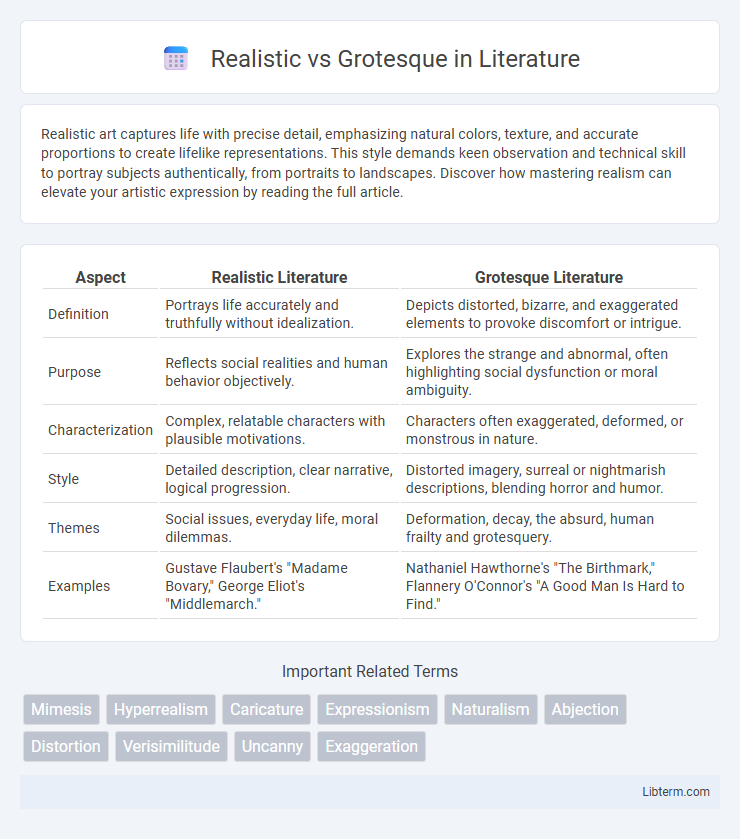Realistic art captures life with precise detail, emphasizing natural colors, texture, and accurate proportions to create lifelike representations. This style demands keen observation and technical skill to portray subjects authentically, from portraits to landscapes. Discover how mastering realism can elevate your artistic expression by reading the full article.
Table of Comparison
| Aspect | Realistic Literature | Grotesque Literature |
|---|---|---|
| Definition | Portrays life accurately and truthfully without idealization. | Depicts distorted, bizarre, and exaggerated elements to provoke discomfort or intrigue. |
| Purpose | Reflects social realities and human behavior objectively. | Explores the strange and abnormal, often highlighting social dysfunction or moral ambiguity. |
| Characterization | Complex, relatable characters with plausible motivations. | Characters often exaggerated, deformed, or monstrous in nature. |
| Style | Detailed description, clear narrative, logical progression. | Distorted imagery, surreal or nightmarish descriptions, blending horror and humor. |
| Themes | Social issues, everyday life, moral dilemmas. | Deformation, decay, the absurd, human frailty and grotesquery. |
| Examples | Gustave Flaubert's "Madame Bovary," George Eliot's "Middlemarch." | Nathaniel Hawthorne's "The Birthmark," Flannery O'Connor's "A Good Man Is Hard to Find." |
Defining Realism and Grotesque
Realism emphasizes accurate, detailed, and unembellished depiction of everyday life, prioritizing true-to-life characters and situations without idealization. The grotesque intertwines distortions, exaggerations, and bizarre elements to evoke discomfort, highlighting the strange or absurd within the human condition. Defining realism involves a commitment to objective representation, while the grotesque challenges norms through surreal, often unsettling imagery.
Historical Origins of Realistic and Grotesque Art
Realistic art originated in the mid-19th century as a response to Romanticism, emphasizing lifelike representation and everyday subjects, deeply rooted in French art movements like the works of Gustave Courbet. Grotesque art traces back to the Renaissance period, inspired by the rediscovery of Roman frescoes in Nero's Domus Aurea, featuring bizarre and fantastical hybrid creatures blending human, animal, and botanical forms. Both styles reflect contrasting approaches: Realistic art strives for accurate depiction of reality, whereas Grotesque art explores exaggerated, distorted, and imaginative visual language.
Key Characteristics of Realistic Style
The key characteristics of the realistic style include detailed representation of everyday life, accurate depiction of ordinary people, and a focus on objective truth without idealization. Realism emphasizes natural settings, plausible events, and authentic dialogue to reflect authentic social conditions and human behavior. This style contrasts sharply with grotesque art, which distorts reality through exaggeration, surreal elements, and dark, often bizarre themes.
Features of the Grotesque Aesthetic
The grotesque aesthetic features distorted and exaggerated forms that evoke a sense of unease or discomfort, often blending human, animal, and machine elements in surreal or monstrous ways. It emphasizes asymmetry, irregularity, and a fusion of the familiar with the bizarre to challenge conventional notions of beauty and normalcy. This aesthetic frequently incorporates dark humor, horror, and the uncanny to provoke emotional and intellectual reactions from the viewer.
Realism vs Grotesque in Literature
Realism in literature emphasizes accurate, detailed depictions of everyday life and society, aiming to reflect reality without exaggeration or idealization. The grotesque introduces distorted, bizarre, or unsettling elements that challenge normal perceptions and evoke both horror and empathy, often highlighting the absurdity of human nature. While realism seeks objective representation, the grotesque exploits exaggeration and the uncanny to reveal deeper psychological or social truths.
Impact on Visual Arts: Realism and Grotesque
Realistic art emphasizes accurate representation and detailed depiction of subjects, fostering viewer connection through lifelike portrayals that highlight everyday experiences. In contrast, grotesque art distorts and exaggerates forms to evoke emotional responses, challenge conventions, and explore the uncanny or surreal aspects of human existence. The interplay between realism and grotesque in visual arts broadens artistic expression, influencing movements like Renaissance naturalism and Expressionist exaggeration.
Emotional and Psychological Effects
Realistic art evokes empathy and a deeper emotional connection by portraying subjects with true-to-life detail, encouraging viewers to relate to the depicted experiences and emotions. Grotesque imagery triggers strong psychological reactions such as discomfort, fear, or fascination, often challenging perceptions and provoking introspection about human nature and societal norms. The contrast between these styles highlights how visual representation influences emotional engagement and cognitive processing in art appreciation.
Realism and Grotesque in Modern Media
Realism in modern media emphasizes authentic depictions of everyday life, highlighting intricate details and relatable characters to foster emotional connection. Grotesque elements exaggerate and distort features or scenarios, creating a sense of discomfort or absurdity that challenges conventional aesthetics and societal norms. This contrast enriches storytelling by balancing immersion with critical reflection on the human condition.
Cultural Interpretations and Symbolism
Realistic art emphasizes accurate depictions of subjects, reflecting cultural ideals of beauty, truth, and human experience, often symbolizing clarity and universality. Grotesque imagery distorts reality with exaggerated, bizarre forms, symbolizing chaos, the subconscious, or societal fears, and varies widely across cultures as a means to critique or reveal hidden truths. The contrast between these styles embodies cultural interpretations of order versus disorder, beauty versus ugliness, and rationality versus emotion.
Choosing Between Realism and Grotesque: Creative Considerations
Choosing between realism and grotesque involves balancing authenticity and exaggeration to evoke specific emotional responses. Realism captures nuanced details and relatable experiences, grounding the audience in familiar contexts, while grotesque distorts reality with bizarre, exaggerated features to challenge perceptions and provoke discomfort. Creative considerations include the desired impact on the viewer, thematic goals, and the narrative tone, ensuring that the chosen style enhances the story's underlying message.
Realistic Infographic

 libterm.com
libterm.com